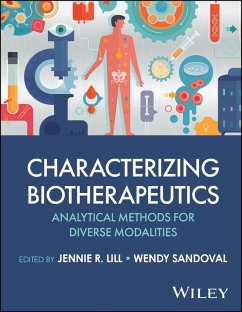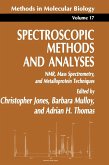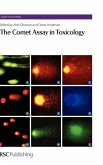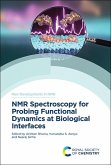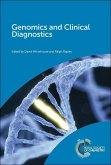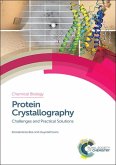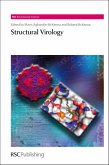JR LillAnalytical Methods for Diverse Modalities
Characterizing Biotherapeutics
Analytical Methods for Diverse Modalities
Herausgeber: Lill, Jennie R; Sandoval, Wendy
JR LillAnalytical Methods for Diverse Modalities
Characterizing Biotherapeutics
Analytical Methods for Diverse Modalities
Herausgeber: Lill, Jennie R; Sandoval, Wendy
- Gebundenes Buch
- Merkliste
- Auf die Merkliste
- Bewerten Bewerten
- Teilen
- Produkt teilen
- Produkterinnerung
- Produkterinnerung
Provides detailed and up-to-date coverage of analytical approaches for biologic drug modalities The development of innovative biologic therapies has revolutionized medicine, but their complexity demands equally advanced analytical approaches. Characterizing Biotherapeutics: Analytical Methods for Diverse Modalities introduces the tools and techniques used to analyze these groundbreaking therapies. Designed to help readers characterize and troubleshoot increasingly diverse and sophisticated therapeutic molecules, this in-depth guide addresses different biologic drugs, their unique analytical…mehr
Andere Kunden interessierten sich auch für
![Spectroscopic Methods and Analyses Spectroscopic Methods and Analyses]() Christopher JonesSpectroscopic Methods and Analyses104,99 €
Christopher JonesSpectroscopic Methods and Analyses104,99 €![Comet Assay in Toxicology Comet Assay in Toxicology]() Comet Assay in Toxicology174,99 €
Comet Assay in Toxicology174,99 €![NMR Spectroscopy for Probing Functional Dynamics at Biological Interfaces NMR Spectroscopy for Probing Functional Dynamics at Biological Interfaces]() NMR Spectroscopy for Probing Functional Dynamics at Biological Interfaces245,99 €
NMR Spectroscopy for Probing Functional Dynamics at Biological Interfaces245,99 €![Genomics and Clinical Diagnostics Genomics and Clinical Diagnostics]() Genomics and Clinical Diagnostics113,99 €
Genomics and Clinical Diagnostics113,99 €![Protein Crystallography Protein Crystallography]() Protein Crystallography198,99 €
Protein Crystallography198,99 €![Applications of Microfluidic Systems in Biology and Medicine Applications of Microfluidic Systems in Biology and Medicine]() Applications of Microfluidic Systems in Biology and Medicine113,99 €
Applications of Microfluidic Systems in Biology and Medicine113,99 €![Structural Virology Structural Virology]() Structural Virology166,99 €
Structural Virology166,99 €-
-
-
Provides detailed and up-to-date coverage of analytical approaches for biologic drug modalities The development of innovative biologic therapies has revolutionized medicine, but their complexity demands equally advanced analytical approaches. Characterizing Biotherapeutics: Analytical Methods for Diverse Modalities introduces the tools and techniques used to analyze these groundbreaking therapies. Designed to help readers characterize and troubleshoot increasingly diverse and sophisticated therapeutic molecules, this in-depth guide addresses different biologic drugs, their unique analytical challenges, and the methods that enable their analysis. Organized into two comprehensive sections, Characterizing Biotherapeutics first delves into the fundamentals of analytical platforms, providing a robust foundation in techniques such as mass spectrometry and biophysical assays. The second section applies these methods to real-world scenarios, focusing on drug discovery, clinical evaluation, and commercial considerations in drug development. Authors Jennie R. Lill and Wendy Sandoval provide clear guidance tailored to the evolving demands of therapeutic innovations such as structural characterization, high-throughput biophysical assays, and RNA-based therapeutics. Equipping researchers with the knowledge to navigate the challenges posed by increasingly complex biologics, Characterizing Biotherapeutics: Analytical Methods for Diverse Modalities: * Discusses new and emerging biological molecule diversity and both traditional analytical methods * Provides characterization strategies for large molecule (protein/antibody) based therapeutics * Summarizes cutting-edge technologies for novel modalities and antibody protein therapeutics * Incorporates the latest advancements in mass spectrometry, functional assays, and biophysical methods * Addresses specialized analytical issues for membrane proteins and other challenging targets * Presents methodologies for assessing safety and therapeutic potential Characterizing Biotherapeutics: Analytical Methods for Diverse Modalities is an essential reference for analytical scientists, biologists, and mass spectrometrists involved in biomolecule analysis. It is also a valuable resource for graduate students taking advanced courses in biotechnology, drug development, and biotherapeutic analysis, as well as professionals in biotechnology and pharmaceutical industries working to advance biotherapeutic research and development.
Produktdetails
- Produktdetails
- Verlag: Wiley
- Seitenzahl: 480
- Erscheinungstermin: 25. Juni 2025
- Englisch
- Abmessung: 281mm x 219mm x 31mm
- Gewicht: 1552g
- ISBN-13: 9781394236114
- ISBN-10: 1394236115
- Artikelnr.: 72221005
- Herstellerkennzeichnung
- Libri GmbH
- Europaallee 1
- 36244 Bad Hersfeld
- gpsr@libri.de
- Verlag: Wiley
- Seitenzahl: 480
- Erscheinungstermin: 25. Juni 2025
- Englisch
- Abmessung: 281mm x 219mm x 31mm
- Gewicht: 1552g
- ISBN-13: 9781394236114
- ISBN-10: 1394236115
- Artikelnr.: 72221005
- Herstellerkennzeichnung
- Libri GmbH
- Europaallee 1
- 36244 Bad Hersfeld
- gpsr@libri.de
Jennie R. Lill, PhD, is the Executive Director of the Proteomic and Genomic Technologies Department at Genentech, where she has worked since 2004. With over 90 peer-reviewed publications and three books, including Analytical Characterization of Biotherapeutics, her work focuses on cutting-edge analytical techniques in drug discovery and development. Wendy Sandoval was the Director of Translational Mass Spectrometry in Research at Genentech, where she had been a pivotal contributor for over 30 years. She has authored more than 100 scientific publications and co-authored two books, including Analytical Characterization of Biotherapeutics. She now runs a plant nursery and botanical garden in Northern California (https://botanicanurseryandgardens.com/) and enjoys playing in dirt.
About the Editors xvii
List of Contributors xix
Preface xxv
1 Introduction 1
Alissa D. Guarnaccia, Wendy Sandoval, and Jennie R. Lill
Exploring a Diversity of Biotherapeutic Approaches 1
Delivering Diverse Biotherapeutics to Expand Patient Treatment 2
Unlocking Innovation: The Role of Biophysical Techniques in Drug Discovery
and Development 2
Increasing Throughput: The Role of High-Quality Analytical Assays in
Characterizing Biotherapeutics 3
The Next Frontier: Additional Bioanalytical Tools and Targets on the
Horizon 3
Artificial Intelligence and Machine Learning: A Transformative Shift for
Computational Tools 4
A Bioanalytical Call to Action! 4
References 5
2 Analytical Characterization of Bispecific Antibodies and Bispecific
Molecules 7
Michael Dillon, T. Noelle Lombana, and Christoph Spiess
Introduction 7
Bispecific Antibodies and Alternative Scaffolds with Tethered Domains 9
Identifying the Best Parental Antibody Pairs to Combine in a BsAb 13
Alternatives to Bispecific Antibodies: Antibody Mixtures 14
Characterization of the Bispecific Molecule 14
Characterization by Mass Spectrometry Methods 15
Conclusions 20
Abbreviations 20
References 21
3 Analytical Challenges in Analyzing IgM Biotherapeutics 29
Amber D. Rolland and Albert J.R. Heck
Introduction 29
Characterization of Biotherapeutic mAbs 31
IgM Sequence and Structure 31
IgM Assembly Factors 35
IgM Glycosylation Patterns 38
IgM Disulfide Bond Networks 44
Conclusions 47
Acknowledgments 48
References 48
4 Mass Spectrometric Characterization of Therapeutic Recombinant Proteins
55
Alissa D. Guarnaccia, Corey E. Bakalarski, Wendy Sandoval, and Jennie R.
Lill
Introduction 55
Instrumentation 55
Software for the Analysis of Intact Molecular Weight Measurements 60
Emerging Mass Spectrometric Approaches for Characterizing Molecular
Heterogeneity in Biotherapeutics 61
Tandem Mass Spectrometric Characterization of Biomolecules 61
Data Acquisition Methods 63
Quantitative Mass Spectrometric Methods 63
Computational Analysis of Tandem Mass Spectra 64
Conclusions and Perspectives 65
Abbreviations 65
References 66
5 Therapeutic Proteins and Hyphenated Methods for Characterization 71
Dietmar Reusch and Markus Haberger
Introduction 71
Methods 71
Considerations 81
Quality Control Feasibility 81
Conclusions 82
References 82
6 Methods for Characterization and Optimization of Peptide Therapeutics:
Bioanalysis and Biotransformation 85
Phillip Chu, Suk-Joon Hyung, Robert S. Jones, S. Cyrus Khojasteh, Dennis H.
Leung, Bin Ma, Huy Nguyen, Emile Plise, Ola M. Saad, John C. Tran, Qinying
Yu, and Xing Zhang
Introduction 85
Acknowledgment 104
References 104
7 Structural Characterization of Biotherapeutics and New Modalities 109
Paola Di Lello and Patrick Lupardus
Introduction 109
Antigens, Epitopes, and Paratopes 109
Recombinant Antigen Generation 116
N-Linked Glycosylation 117
Manipulating N-Linked Glycans on Antigens 118
Antibody Generation for Crystallography 119
Crystallization of Antibody/Antigen Complexes 119
Consideration for New Modalities and New Targets 120
Conclusion 121
Abbreviations 121
References 122
8 Modern Methods for Characterizing the Higher-Order Structure (HOS) of
Biotherapeutics 129
Felix Kuhne, Rachel P. Liu, Lingfei Wang, Aaron T. Wecksler, Manasi
Gaikwad, Christine C. Jao, Alberto Estevez, Roshan M. Regy, and Saeed Izadi
Protein Higher-Order Structure (HOS) 129
Importance of HOS Characterization in Biotherapeutic Development 131
Hydrogen/Deuterium Exchange Mass Spectrometry (H/DX-MS) 134
Hydroxyl Radical Protein Footprinting Mass Spectrometry (HRPF-MS) 137
Covalent Labeling Mass Spectrometry (CL-MS) 139
X-Ray Crystallography 141
Cryogenic Electron Microscopy (Cryo-EM) 145
Multiscale in-silico Modeling of Biotherapeutics 149
Conclusion 153
References 153
9 Target Binding Assays for Biotherapeutics 161
Eric Janezic and Xiangdan Wang
Introduction 161
Assays to Determine Affinity of Biotherapeutics 161
Cell-Based Affinity assays 166
Conclusions 171
References 172
10 Functional Assays for Screening Protein Biotherapeutics 175
Maureen Beresini and Kelly Loyet
Introduction 175
Development of a Screening Cascade 175
Biochemical Assays for Cellular Receptor-Binding or Extracellular Targets
180
Cellular Assays for a Cell Signaling Readout 181
Fundamentals of Assay Development, Validation, and Implementation 187
Concluding Remarks 192
References 193
11 Immunogenicity Profiling of Biotherapeutics (Wiley Book - Bioanalytical
Characterization of New Therapeutic Modalities) 197
Qui T. Phung, M. Violet Lee, Ola Saad, Sivan Cohen, Yinyin Li, Mercedesz
Balasz, Jieming Chen, Zhaojun Yin, Zhenru Zhou, and Jennie R. Lill
Introduction 197
The Anti-drug Antibody Response 199
Clinical Monitoring of ADAs 200
ADA Assay Development Challenges and Considerations for New Modalities 201
Integrating Immunogenicity Assessments, Harmonization, and Incorporation of
Clinically Relevant Information into Drug Product Labeling 201
The Clinical Impact of an ADA 201
Assays Employed to Assess Immunogenicity Risk 202
In Silico Approaches for Immunogenicity Risk Assessment 202
T-Cell and Other Cellular Assays 205
MHC II Immunopeptidome 209
Data Visualization and Curation 214
Engineering Best Practices Post-immunogenicity Hotspot Data Elucidation 214
Conclusion 215
Abbreviations 215
References 216
12 High-Throughput Biophysical Assays for Developability Assessment 223
Emma Pelegri-O'Day and Nithya Srinivasan
Introduction 223
High-Throughput Intact Mass Spectrometry 223
Aggregation 225
Size Variants 226
Hydrophobicity 227
Charge Variants 227
Viscosity 229
Conformational Stability 230
Chemical Stability Assessment 231
Leveraging AI/ML for Molecule Assessment 233
Future of Developability Assessments 234
References 235
13 Establishing Analytical Methods for RNA-Based Therapeutics
Characterization 243
Julien Camperi, Emily Freund, Carolina Galan, and Axel Guilbaud
Introduction to RNA-Based Therapeutics 243
Applications of RNA-Based Drugs 243
Quality Attributes and Techniques for the Characterization of mRNA 245
RNA Integrity and Purity 247
mRNA Quality Features 250
Functionality Testing 252
Conclusion 255
References 256
14 Analytical Methods Shaping Cell Therapy Characterization 261
Amritha Lewis, Sadhu Sudeshna, Melmon Rebecca, Shaik Rahamthulla,
Tutuncuoglu Egemen, and Gilbert Amy
Introduction 261
Fundamentals of T-Cell Immunology in Cell Therapy 262
Measuring Immune Receptor Expression 262
Functional Cell-Based Assays for In Vitro Characterization 264
Cell Phenotyping 265
Immune Monitoring: BCR and TCR Sequencing 266
Conclusions 267
Acknowledgment 267
References 267
15 Characterizing Nucleic Acid-, Gene-, and Cell-Based Therapeutics with
Sequencing Technologies 271
Hayley M. Bennett, Ashley Byrne, William Stephenson, and Zora Modrusan
Introduction 271
DNA Sequencing 271
Nucleic-Acid-Based Therapeutics 274
Gene-Based Therapies 277
Cell-Based Therapies 279
Immune Repertoire Sequencing Facilitates Therapeutic Advances 280
Conclusions and Future Perspectives 282
Abbreviations 282
References 283
16 Mass Spectrometry-Based Methods to Investigate Protein-Protein
Interactions in Cells and Their Application in Drug Discovery 289
Tess Branon
Introduction 289
Affinity Purification Mass Spectrometry (AP-MS) 290
Cross-Linking Mass Spectrometry (XL-MS) 293
Proximity Labeling Mass Spectrometry (PL-MS) 296
Concluding Remarks and Other Interactomic Technologies 302
Abbreviations 307
References 308
17 Receptomics and Extracellular Interactomics for Biotherapeutic
Characterization 321
Naincy R. Chandan, Abel Ferrel, and Shengya Cao
Introduction 321
Receptomic and Extracellular Interactomics Technology Overview 322
Natural Products and Peptides 325
Antibodies and Related Proteins 326
Lipid Nanoparticles (LNPs), Extracellular Vesicles (EVs), Virus-Like
Particles (VLPs) and Viruses 331
Cell Therapies 332
Summary 334
Abbreviations 334
References 335
18 Membrane Proteins: Challenging Biotherapeutic Targets 341
Hiruni S. Jayasekera, Farhana Afrin Mohona, and Michael T. Marty
Membrane Proteins: Challenging Biotherapeutic Targets Families of Membrane
Proteins 341
Membrane Protein Solubilization Methods 344
MS Analysis of Membrane Proteins 349
Conclusion 353
Acknowledgments 353
References 353
19 Chemoproteomics Approaches for Diverse Modalities 365
H. Christian Eberl, Sascha Knecht, Markus A. Queisser, and Marcus
Bantscheff
Introduction 365
Chemoproteomics Approaches 367
Probe-Based (Direct) Target Deconvolution 367
Target Deconvolution Without Chemical Probes 369
Proximity-Labeling Approaches 370
Mechanism-Centric (Indirect) Proteomics Methods 370
Covalent Drugs 370
Protein Degraders 373
Antibody-Drug Conjugates and Oligonucleotides 377
Concluding Remarks 378
Acknowledgments 379
Abbreviations 379
References 379
20 Drug-Delivery Modalities and Mechanisms 385
Yu Tong Tam, Madyson Migliozzi, Devin B. Tesar, Amin Famili, Aaron T.
Wecksler, Sara Wichner, Alavattam Sreedhara, and Whitney Shatz-Binder
Introduction 385
Delivery of Proteins 387
Delivering Genes to the Immune System: Enabling Cell-Specific Targeting 399
Tissue-Specific Delivery: Targeting the Brain Parenchyma 402
Direct Injection 402
Next-Generation Approaches with Some Clinical Data 403
An Analytical Perspective to Drug-Delivery Technology Development 409
Conclusions/Future Perspectives 419
Abbreviations 421
References 422
Index 439
List of Contributors xix
Preface xxv
1 Introduction 1
Alissa D. Guarnaccia, Wendy Sandoval, and Jennie R. Lill
Exploring a Diversity of Biotherapeutic Approaches 1
Delivering Diverse Biotherapeutics to Expand Patient Treatment 2
Unlocking Innovation: The Role of Biophysical Techniques in Drug Discovery
and Development 2
Increasing Throughput: The Role of High-Quality Analytical Assays in
Characterizing Biotherapeutics 3
The Next Frontier: Additional Bioanalytical Tools and Targets on the
Horizon 3
Artificial Intelligence and Machine Learning: A Transformative Shift for
Computational Tools 4
A Bioanalytical Call to Action! 4
References 5
2 Analytical Characterization of Bispecific Antibodies and Bispecific
Molecules 7
Michael Dillon, T. Noelle Lombana, and Christoph Spiess
Introduction 7
Bispecific Antibodies and Alternative Scaffolds with Tethered Domains 9
Identifying the Best Parental Antibody Pairs to Combine in a BsAb 13
Alternatives to Bispecific Antibodies: Antibody Mixtures 14
Characterization of the Bispecific Molecule 14
Characterization by Mass Spectrometry Methods 15
Conclusions 20
Abbreviations 20
References 21
3 Analytical Challenges in Analyzing IgM Biotherapeutics 29
Amber D. Rolland and Albert J.R. Heck
Introduction 29
Characterization of Biotherapeutic mAbs 31
IgM Sequence and Structure 31
IgM Assembly Factors 35
IgM Glycosylation Patterns 38
IgM Disulfide Bond Networks 44
Conclusions 47
Acknowledgments 48
References 48
4 Mass Spectrometric Characterization of Therapeutic Recombinant Proteins
55
Alissa D. Guarnaccia, Corey E. Bakalarski, Wendy Sandoval, and Jennie R.
Lill
Introduction 55
Instrumentation 55
Software for the Analysis of Intact Molecular Weight Measurements 60
Emerging Mass Spectrometric Approaches for Characterizing Molecular
Heterogeneity in Biotherapeutics 61
Tandem Mass Spectrometric Characterization of Biomolecules 61
Data Acquisition Methods 63
Quantitative Mass Spectrometric Methods 63
Computational Analysis of Tandem Mass Spectra 64
Conclusions and Perspectives 65
Abbreviations 65
References 66
5 Therapeutic Proteins and Hyphenated Methods for Characterization 71
Dietmar Reusch and Markus Haberger
Introduction 71
Methods 71
Considerations 81
Quality Control Feasibility 81
Conclusions 82
References 82
6 Methods for Characterization and Optimization of Peptide Therapeutics:
Bioanalysis and Biotransformation 85
Phillip Chu, Suk-Joon Hyung, Robert S. Jones, S. Cyrus Khojasteh, Dennis H.
Leung, Bin Ma, Huy Nguyen, Emile Plise, Ola M. Saad, John C. Tran, Qinying
Yu, and Xing Zhang
Introduction 85
Acknowledgment 104
References 104
7 Structural Characterization of Biotherapeutics and New Modalities 109
Paola Di Lello and Patrick Lupardus
Introduction 109
Antigens, Epitopes, and Paratopes 109
Recombinant Antigen Generation 116
N-Linked Glycosylation 117
Manipulating N-Linked Glycans on Antigens 118
Antibody Generation for Crystallography 119
Crystallization of Antibody/Antigen Complexes 119
Consideration for New Modalities and New Targets 120
Conclusion 121
Abbreviations 121
References 122
8 Modern Methods for Characterizing the Higher-Order Structure (HOS) of
Biotherapeutics 129
Felix Kuhne, Rachel P. Liu, Lingfei Wang, Aaron T. Wecksler, Manasi
Gaikwad, Christine C. Jao, Alberto Estevez, Roshan M. Regy, and Saeed Izadi
Protein Higher-Order Structure (HOS) 129
Importance of HOS Characterization in Biotherapeutic Development 131
Hydrogen/Deuterium Exchange Mass Spectrometry (H/DX-MS) 134
Hydroxyl Radical Protein Footprinting Mass Spectrometry (HRPF-MS) 137
Covalent Labeling Mass Spectrometry (CL-MS) 139
X-Ray Crystallography 141
Cryogenic Electron Microscopy (Cryo-EM) 145
Multiscale in-silico Modeling of Biotherapeutics 149
Conclusion 153
References 153
9 Target Binding Assays for Biotherapeutics 161
Eric Janezic and Xiangdan Wang
Introduction 161
Assays to Determine Affinity of Biotherapeutics 161
Cell-Based Affinity assays 166
Conclusions 171
References 172
10 Functional Assays for Screening Protein Biotherapeutics 175
Maureen Beresini and Kelly Loyet
Introduction 175
Development of a Screening Cascade 175
Biochemical Assays for Cellular Receptor-Binding or Extracellular Targets
180
Cellular Assays for a Cell Signaling Readout 181
Fundamentals of Assay Development, Validation, and Implementation 187
Concluding Remarks 192
References 193
11 Immunogenicity Profiling of Biotherapeutics (Wiley Book - Bioanalytical
Characterization of New Therapeutic Modalities) 197
Qui T. Phung, M. Violet Lee, Ola Saad, Sivan Cohen, Yinyin Li, Mercedesz
Balasz, Jieming Chen, Zhaojun Yin, Zhenru Zhou, and Jennie R. Lill
Introduction 197
The Anti-drug Antibody Response 199
Clinical Monitoring of ADAs 200
ADA Assay Development Challenges and Considerations for New Modalities 201
Integrating Immunogenicity Assessments, Harmonization, and Incorporation of
Clinically Relevant Information into Drug Product Labeling 201
The Clinical Impact of an ADA 201
Assays Employed to Assess Immunogenicity Risk 202
In Silico Approaches for Immunogenicity Risk Assessment 202
T-Cell and Other Cellular Assays 205
MHC II Immunopeptidome 209
Data Visualization and Curation 214
Engineering Best Practices Post-immunogenicity Hotspot Data Elucidation 214
Conclusion 215
Abbreviations 215
References 216
12 High-Throughput Biophysical Assays for Developability Assessment 223
Emma Pelegri-O'Day and Nithya Srinivasan
Introduction 223
High-Throughput Intact Mass Spectrometry 223
Aggregation 225
Size Variants 226
Hydrophobicity 227
Charge Variants 227
Viscosity 229
Conformational Stability 230
Chemical Stability Assessment 231
Leveraging AI/ML for Molecule Assessment 233
Future of Developability Assessments 234
References 235
13 Establishing Analytical Methods for RNA-Based Therapeutics
Characterization 243
Julien Camperi, Emily Freund, Carolina Galan, and Axel Guilbaud
Introduction to RNA-Based Therapeutics 243
Applications of RNA-Based Drugs 243
Quality Attributes and Techniques for the Characterization of mRNA 245
RNA Integrity and Purity 247
mRNA Quality Features 250
Functionality Testing 252
Conclusion 255
References 256
14 Analytical Methods Shaping Cell Therapy Characterization 261
Amritha Lewis, Sadhu Sudeshna, Melmon Rebecca, Shaik Rahamthulla,
Tutuncuoglu Egemen, and Gilbert Amy
Introduction 261
Fundamentals of T-Cell Immunology in Cell Therapy 262
Measuring Immune Receptor Expression 262
Functional Cell-Based Assays for In Vitro Characterization 264
Cell Phenotyping 265
Immune Monitoring: BCR and TCR Sequencing 266
Conclusions 267
Acknowledgment 267
References 267
15 Characterizing Nucleic Acid-, Gene-, and Cell-Based Therapeutics with
Sequencing Technologies 271
Hayley M. Bennett, Ashley Byrne, William Stephenson, and Zora Modrusan
Introduction 271
DNA Sequencing 271
Nucleic-Acid-Based Therapeutics 274
Gene-Based Therapies 277
Cell-Based Therapies 279
Immune Repertoire Sequencing Facilitates Therapeutic Advances 280
Conclusions and Future Perspectives 282
Abbreviations 282
References 283
16 Mass Spectrometry-Based Methods to Investigate Protein-Protein
Interactions in Cells and Their Application in Drug Discovery 289
Tess Branon
Introduction 289
Affinity Purification Mass Spectrometry (AP-MS) 290
Cross-Linking Mass Spectrometry (XL-MS) 293
Proximity Labeling Mass Spectrometry (PL-MS) 296
Concluding Remarks and Other Interactomic Technologies 302
Abbreviations 307
References 308
17 Receptomics and Extracellular Interactomics for Biotherapeutic
Characterization 321
Naincy R. Chandan, Abel Ferrel, and Shengya Cao
Introduction 321
Receptomic and Extracellular Interactomics Technology Overview 322
Natural Products and Peptides 325
Antibodies and Related Proteins 326
Lipid Nanoparticles (LNPs), Extracellular Vesicles (EVs), Virus-Like
Particles (VLPs) and Viruses 331
Cell Therapies 332
Summary 334
Abbreviations 334
References 335
18 Membrane Proteins: Challenging Biotherapeutic Targets 341
Hiruni S. Jayasekera, Farhana Afrin Mohona, and Michael T. Marty
Membrane Proteins: Challenging Biotherapeutic Targets Families of Membrane
Proteins 341
Membrane Protein Solubilization Methods 344
MS Analysis of Membrane Proteins 349
Conclusion 353
Acknowledgments 353
References 353
19 Chemoproteomics Approaches for Diverse Modalities 365
H. Christian Eberl, Sascha Knecht, Markus A. Queisser, and Marcus
Bantscheff
Introduction 365
Chemoproteomics Approaches 367
Probe-Based (Direct) Target Deconvolution 367
Target Deconvolution Without Chemical Probes 369
Proximity-Labeling Approaches 370
Mechanism-Centric (Indirect) Proteomics Methods 370
Covalent Drugs 370
Protein Degraders 373
Antibody-Drug Conjugates and Oligonucleotides 377
Concluding Remarks 378
Acknowledgments 379
Abbreviations 379
References 379
20 Drug-Delivery Modalities and Mechanisms 385
Yu Tong Tam, Madyson Migliozzi, Devin B. Tesar, Amin Famili, Aaron T.
Wecksler, Sara Wichner, Alavattam Sreedhara, and Whitney Shatz-Binder
Introduction 385
Delivery of Proteins 387
Delivering Genes to the Immune System: Enabling Cell-Specific Targeting 399
Tissue-Specific Delivery: Targeting the Brain Parenchyma 402
Direct Injection 402
Next-Generation Approaches with Some Clinical Data 403
An Analytical Perspective to Drug-Delivery Technology Development 409
Conclusions/Future Perspectives 419
Abbreviations 421
References 422
Index 439
About the Editors xvii
List of Contributors xix
Preface xxv
1 Introduction 1
Alissa D. Guarnaccia, Wendy Sandoval, and Jennie R. Lill
Exploring a Diversity of Biotherapeutic Approaches 1
Delivering Diverse Biotherapeutics to Expand Patient Treatment 2
Unlocking Innovation: The Role of Biophysical Techniques in Drug Discovery
and Development 2
Increasing Throughput: The Role of High-Quality Analytical Assays in
Characterizing Biotherapeutics 3
The Next Frontier: Additional Bioanalytical Tools and Targets on the
Horizon 3
Artificial Intelligence and Machine Learning: A Transformative Shift for
Computational Tools 4
A Bioanalytical Call to Action! 4
References 5
2 Analytical Characterization of Bispecific Antibodies and Bispecific
Molecules 7
Michael Dillon, T. Noelle Lombana, and Christoph Spiess
Introduction 7
Bispecific Antibodies and Alternative Scaffolds with Tethered Domains 9
Identifying the Best Parental Antibody Pairs to Combine in a BsAb 13
Alternatives to Bispecific Antibodies: Antibody Mixtures 14
Characterization of the Bispecific Molecule 14
Characterization by Mass Spectrometry Methods 15
Conclusions 20
Abbreviations 20
References 21
3 Analytical Challenges in Analyzing IgM Biotherapeutics 29
Amber D. Rolland and Albert J.R. Heck
Introduction 29
Characterization of Biotherapeutic mAbs 31
IgM Sequence and Structure 31
IgM Assembly Factors 35
IgM Glycosylation Patterns 38
IgM Disulfide Bond Networks 44
Conclusions 47
Acknowledgments 48
References 48
4 Mass Spectrometric Characterization of Therapeutic Recombinant Proteins
55
Alissa D. Guarnaccia, Corey E. Bakalarski, Wendy Sandoval, and Jennie R.
Lill
Introduction 55
Instrumentation 55
Software for the Analysis of Intact Molecular Weight Measurements 60
Emerging Mass Spectrometric Approaches for Characterizing Molecular
Heterogeneity in Biotherapeutics 61
Tandem Mass Spectrometric Characterization of Biomolecules 61
Data Acquisition Methods 63
Quantitative Mass Spectrometric Methods 63
Computational Analysis of Tandem Mass Spectra 64
Conclusions and Perspectives 65
Abbreviations 65
References 66
5 Therapeutic Proteins and Hyphenated Methods for Characterization 71
Dietmar Reusch and Markus Haberger
Introduction 71
Methods 71
Considerations 81
Quality Control Feasibility 81
Conclusions 82
References 82
6 Methods for Characterization and Optimization of Peptide Therapeutics:
Bioanalysis and Biotransformation 85
Phillip Chu, Suk-Joon Hyung, Robert S. Jones, S. Cyrus Khojasteh, Dennis H.
Leung, Bin Ma, Huy Nguyen, Emile Plise, Ola M. Saad, John C. Tran, Qinying
Yu, and Xing Zhang
Introduction 85
Acknowledgment 104
References 104
7 Structural Characterization of Biotherapeutics and New Modalities 109
Paola Di Lello and Patrick Lupardus
Introduction 109
Antigens, Epitopes, and Paratopes 109
Recombinant Antigen Generation 116
N-Linked Glycosylation 117
Manipulating N-Linked Glycans on Antigens 118
Antibody Generation for Crystallography 119
Crystallization of Antibody/Antigen Complexes 119
Consideration for New Modalities and New Targets 120
Conclusion 121
Abbreviations 121
References 122
8 Modern Methods for Characterizing the Higher-Order Structure (HOS) of
Biotherapeutics 129
Felix Kuhne, Rachel P. Liu, Lingfei Wang, Aaron T. Wecksler, Manasi
Gaikwad, Christine C. Jao, Alberto Estevez, Roshan M. Regy, and Saeed Izadi
Protein Higher-Order Structure (HOS) 129
Importance of HOS Characterization in Biotherapeutic Development 131
Hydrogen/Deuterium Exchange Mass Spectrometry (H/DX-MS) 134
Hydroxyl Radical Protein Footprinting Mass Spectrometry (HRPF-MS) 137
Covalent Labeling Mass Spectrometry (CL-MS) 139
X-Ray Crystallography 141
Cryogenic Electron Microscopy (Cryo-EM) 145
Multiscale in-silico Modeling of Biotherapeutics 149
Conclusion 153
References 153
9 Target Binding Assays for Biotherapeutics 161
Eric Janezic and Xiangdan Wang
Introduction 161
Assays to Determine Affinity of Biotherapeutics 161
Cell-Based Affinity assays 166
Conclusions 171
References 172
10 Functional Assays for Screening Protein Biotherapeutics 175
Maureen Beresini and Kelly Loyet
Introduction 175
Development of a Screening Cascade 175
Biochemical Assays for Cellular Receptor-Binding or Extracellular Targets
180
Cellular Assays for a Cell Signaling Readout 181
Fundamentals of Assay Development, Validation, and Implementation 187
Concluding Remarks 192
References 193
11 Immunogenicity Profiling of Biotherapeutics (Wiley Book - Bioanalytical
Characterization of New Therapeutic Modalities) 197
Qui T. Phung, M. Violet Lee, Ola Saad, Sivan Cohen, Yinyin Li, Mercedesz
Balasz, Jieming Chen, Zhaojun Yin, Zhenru Zhou, and Jennie R. Lill
Introduction 197
The Anti-drug Antibody Response 199
Clinical Monitoring of ADAs 200
ADA Assay Development Challenges and Considerations for New Modalities 201
Integrating Immunogenicity Assessments, Harmonization, and Incorporation of
Clinically Relevant Information into Drug Product Labeling 201
The Clinical Impact of an ADA 201
Assays Employed to Assess Immunogenicity Risk 202
In Silico Approaches for Immunogenicity Risk Assessment 202
T-Cell and Other Cellular Assays 205
MHC II Immunopeptidome 209
Data Visualization and Curation 214
Engineering Best Practices Post-immunogenicity Hotspot Data Elucidation 214
Conclusion 215
Abbreviations 215
References 216
12 High-Throughput Biophysical Assays for Developability Assessment 223
Emma Pelegri-O'Day and Nithya Srinivasan
Introduction 223
High-Throughput Intact Mass Spectrometry 223
Aggregation 225
Size Variants 226
Hydrophobicity 227
Charge Variants 227
Viscosity 229
Conformational Stability 230
Chemical Stability Assessment 231
Leveraging AI/ML for Molecule Assessment 233
Future of Developability Assessments 234
References 235
13 Establishing Analytical Methods for RNA-Based Therapeutics
Characterization 243
Julien Camperi, Emily Freund, Carolina Galan, and Axel Guilbaud
Introduction to RNA-Based Therapeutics 243
Applications of RNA-Based Drugs 243
Quality Attributes and Techniques for the Characterization of mRNA 245
RNA Integrity and Purity 247
mRNA Quality Features 250
Functionality Testing 252
Conclusion 255
References 256
14 Analytical Methods Shaping Cell Therapy Characterization 261
Amritha Lewis, Sadhu Sudeshna, Melmon Rebecca, Shaik Rahamthulla,
Tutuncuoglu Egemen, and Gilbert Amy
Introduction 261
Fundamentals of T-Cell Immunology in Cell Therapy 262
Measuring Immune Receptor Expression 262
Functional Cell-Based Assays for In Vitro Characterization 264
Cell Phenotyping 265
Immune Monitoring: BCR and TCR Sequencing 266
Conclusions 267
Acknowledgment 267
References 267
15 Characterizing Nucleic Acid-, Gene-, and Cell-Based Therapeutics with
Sequencing Technologies 271
Hayley M. Bennett, Ashley Byrne, William Stephenson, and Zora Modrusan
Introduction 271
DNA Sequencing 271
Nucleic-Acid-Based Therapeutics 274
Gene-Based Therapies 277
Cell-Based Therapies 279
Immune Repertoire Sequencing Facilitates Therapeutic Advances 280
Conclusions and Future Perspectives 282
Abbreviations 282
References 283
16 Mass Spectrometry-Based Methods to Investigate Protein-Protein
Interactions in Cells and Their Application in Drug Discovery 289
Tess Branon
Introduction 289
Affinity Purification Mass Spectrometry (AP-MS) 290
Cross-Linking Mass Spectrometry (XL-MS) 293
Proximity Labeling Mass Spectrometry (PL-MS) 296
Concluding Remarks and Other Interactomic Technologies 302
Abbreviations 307
References 308
17 Receptomics and Extracellular Interactomics for Biotherapeutic
Characterization 321
Naincy R. Chandan, Abel Ferrel, and Shengya Cao
Introduction 321
Receptomic and Extracellular Interactomics Technology Overview 322
Natural Products and Peptides 325
Antibodies and Related Proteins 326
Lipid Nanoparticles (LNPs), Extracellular Vesicles (EVs), Virus-Like
Particles (VLPs) and Viruses 331
Cell Therapies 332
Summary 334
Abbreviations 334
References 335
18 Membrane Proteins: Challenging Biotherapeutic Targets 341
Hiruni S. Jayasekera, Farhana Afrin Mohona, and Michael T. Marty
Membrane Proteins: Challenging Biotherapeutic Targets Families of Membrane
Proteins 341
Membrane Protein Solubilization Methods 344
MS Analysis of Membrane Proteins 349
Conclusion 353
Acknowledgments 353
References 353
19 Chemoproteomics Approaches for Diverse Modalities 365
H. Christian Eberl, Sascha Knecht, Markus A. Queisser, and Marcus
Bantscheff
Introduction 365
Chemoproteomics Approaches 367
Probe-Based (Direct) Target Deconvolution 367
Target Deconvolution Without Chemical Probes 369
Proximity-Labeling Approaches 370
Mechanism-Centric (Indirect) Proteomics Methods 370
Covalent Drugs 370
Protein Degraders 373
Antibody-Drug Conjugates and Oligonucleotides 377
Concluding Remarks 378
Acknowledgments 379
Abbreviations 379
References 379
20 Drug-Delivery Modalities and Mechanisms 385
Yu Tong Tam, Madyson Migliozzi, Devin B. Tesar, Amin Famili, Aaron T.
Wecksler, Sara Wichner, Alavattam Sreedhara, and Whitney Shatz-Binder
Introduction 385
Delivery of Proteins 387
Delivering Genes to the Immune System: Enabling Cell-Specific Targeting 399
Tissue-Specific Delivery: Targeting the Brain Parenchyma 402
Direct Injection 402
Next-Generation Approaches with Some Clinical Data 403
An Analytical Perspective to Drug-Delivery Technology Development 409
Conclusions/Future Perspectives 419
Abbreviations 421
References 422
Index 439
List of Contributors xix
Preface xxv
1 Introduction 1
Alissa D. Guarnaccia, Wendy Sandoval, and Jennie R. Lill
Exploring a Diversity of Biotherapeutic Approaches 1
Delivering Diverse Biotherapeutics to Expand Patient Treatment 2
Unlocking Innovation: The Role of Biophysical Techniques in Drug Discovery
and Development 2
Increasing Throughput: The Role of High-Quality Analytical Assays in
Characterizing Biotherapeutics 3
The Next Frontier: Additional Bioanalytical Tools and Targets on the
Horizon 3
Artificial Intelligence and Machine Learning: A Transformative Shift for
Computational Tools 4
A Bioanalytical Call to Action! 4
References 5
2 Analytical Characterization of Bispecific Antibodies and Bispecific
Molecules 7
Michael Dillon, T. Noelle Lombana, and Christoph Spiess
Introduction 7
Bispecific Antibodies and Alternative Scaffolds with Tethered Domains 9
Identifying the Best Parental Antibody Pairs to Combine in a BsAb 13
Alternatives to Bispecific Antibodies: Antibody Mixtures 14
Characterization of the Bispecific Molecule 14
Characterization by Mass Spectrometry Methods 15
Conclusions 20
Abbreviations 20
References 21
3 Analytical Challenges in Analyzing IgM Biotherapeutics 29
Amber D. Rolland and Albert J.R. Heck
Introduction 29
Characterization of Biotherapeutic mAbs 31
IgM Sequence and Structure 31
IgM Assembly Factors 35
IgM Glycosylation Patterns 38
IgM Disulfide Bond Networks 44
Conclusions 47
Acknowledgments 48
References 48
4 Mass Spectrometric Characterization of Therapeutic Recombinant Proteins
55
Alissa D. Guarnaccia, Corey E. Bakalarski, Wendy Sandoval, and Jennie R.
Lill
Introduction 55
Instrumentation 55
Software for the Analysis of Intact Molecular Weight Measurements 60
Emerging Mass Spectrometric Approaches for Characterizing Molecular
Heterogeneity in Biotherapeutics 61
Tandem Mass Spectrometric Characterization of Biomolecules 61
Data Acquisition Methods 63
Quantitative Mass Spectrometric Methods 63
Computational Analysis of Tandem Mass Spectra 64
Conclusions and Perspectives 65
Abbreviations 65
References 66
5 Therapeutic Proteins and Hyphenated Methods for Characterization 71
Dietmar Reusch and Markus Haberger
Introduction 71
Methods 71
Considerations 81
Quality Control Feasibility 81
Conclusions 82
References 82
6 Methods for Characterization and Optimization of Peptide Therapeutics:
Bioanalysis and Biotransformation 85
Phillip Chu, Suk-Joon Hyung, Robert S. Jones, S. Cyrus Khojasteh, Dennis H.
Leung, Bin Ma, Huy Nguyen, Emile Plise, Ola M. Saad, John C. Tran, Qinying
Yu, and Xing Zhang
Introduction 85
Acknowledgment 104
References 104
7 Structural Characterization of Biotherapeutics and New Modalities 109
Paola Di Lello and Patrick Lupardus
Introduction 109
Antigens, Epitopes, and Paratopes 109
Recombinant Antigen Generation 116
N-Linked Glycosylation 117
Manipulating N-Linked Glycans on Antigens 118
Antibody Generation for Crystallography 119
Crystallization of Antibody/Antigen Complexes 119
Consideration for New Modalities and New Targets 120
Conclusion 121
Abbreviations 121
References 122
8 Modern Methods for Characterizing the Higher-Order Structure (HOS) of
Biotherapeutics 129
Felix Kuhne, Rachel P. Liu, Lingfei Wang, Aaron T. Wecksler, Manasi
Gaikwad, Christine C. Jao, Alberto Estevez, Roshan M. Regy, and Saeed Izadi
Protein Higher-Order Structure (HOS) 129
Importance of HOS Characterization in Biotherapeutic Development 131
Hydrogen/Deuterium Exchange Mass Spectrometry (H/DX-MS) 134
Hydroxyl Radical Protein Footprinting Mass Spectrometry (HRPF-MS) 137
Covalent Labeling Mass Spectrometry (CL-MS) 139
X-Ray Crystallography 141
Cryogenic Electron Microscopy (Cryo-EM) 145
Multiscale in-silico Modeling of Biotherapeutics 149
Conclusion 153
References 153
9 Target Binding Assays for Biotherapeutics 161
Eric Janezic and Xiangdan Wang
Introduction 161
Assays to Determine Affinity of Biotherapeutics 161
Cell-Based Affinity assays 166
Conclusions 171
References 172
10 Functional Assays for Screening Protein Biotherapeutics 175
Maureen Beresini and Kelly Loyet
Introduction 175
Development of a Screening Cascade 175
Biochemical Assays for Cellular Receptor-Binding or Extracellular Targets
180
Cellular Assays for a Cell Signaling Readout 181
Fundamentals of Assay Development, Validation, and Implementation 187
Concluding Remarks 192
References 193
11 Immunogenicity Profiling of Biotherapeutics (Wiley Book - Bioanalytical
Characterization of New Therapeutic Modalities) 197
Qui T. Phung, M. Violet Lee, Ola Saad, Sivan Cohen, Yinyin Li, Mercedesz
Balasz, Jieming Chen, Zhaojun Yin, Zhenru Zhou, and Jennie R. Lill
Introduction 197
The Anti-drug Antibody Response 199
Clinical Monitoring of ADAs 200
ADA Assay Development Challenges and Considerations for New Modalities 201
Integrating Immunogenicity Assessments, Harmonization, and Incorporation of
Clinically Relevant Information into Drug Product Labeling 201
The Clinical Impact of an ADA 201
Assays Employed to Assess Immunogenicity Risk 202
In Silico Approaches for Immunogenicity Risk Assessment 202
T-Cell and Other Cellular Assays 205
MHC II Immunopeptidome 209
Data Visualization and Curation 214
Engineering Best Practices Post-immunogenicity Hotspot Data Elucidation 214
Conclusion 215
Abbreviations 215
References 216
12 High-Throughput Biophysical Assays for Developability Assessment 223
Emma Pelegri-O'Day and Nithya Srinivasan
Introduction 223
High-Throughput Intact Mass Spectrometry 223
Aggregation 225
Size Variants 226
Hydrophobicity 227
Charge Variants 227
Viscosity 229
Conformational Stability 230
Chemical Stability Assessment 231
Leveraging AI/ML for Molecule Assessment 233
Future of Developability Assessments 234
References 235
13 Establishing Analytical Methods for RNA-Based Therapeutics
Characterization 243
Julien Camperi, Emily Freund, Carolina Galan, and Axel Guilbaud
Introduction to RNA-Based Therapeutics 243
Applications of RNA-Based Drugs 243
Quality Attributes and Techniques for the Characterization of mRNA 245
RNA Integrity and Purity 247
mRNA Quality Features 250
Functionality Testing 252
Conclusion 255
References 256
14 Analytical Methods Shaping Cell Therapy Characterization 261
Amritha Lewis, Sadhu Sudeshna, Melmon Rebecca, Shaik Rahamthulla,
Tutuncuoglu Egemen, and Gilbert Amy
Introduction 261
Fundamentals of T-Cell Immunology in Cell Therapy 262
Measuring Immune Receptor Expression 262
Functional Cell-Based Assays for In Vitro Characterization 264
Cell Phenotyping 265
Immune Monitoring: BCR and TCR Sequencing 266
Conclusions 267
Acknowledgment 267
References 267
15 Characterizing Nucleic Acid-, Gene-, and Cell-Based Therapeutics with
Sequencing Technologies 271
Hayley M. Bennett, Ashley Byrne, William Stephenson, and Zora Modrusan
Introduction 271
DNA Sequencing 271
Nucleic-Acid-Based Therapeutics 274
Gene-Based Therapies 277
Cell-Based Therapies 279
Immune Repertoire Sequencing Facilitates Therapeutic Advances 280
Conclusions and Future Perspectives 282
Abbreviations 282
References 283
16 Mass Spectrometry-Based Methods to Investigate Protein-Protein
Interactions in Cells and Their Application in Drug Discovery 289
Tess Branon
Introduction 289
Affinity Purification Mass Spectrometry (AP-MS) 290
Cross-Linking Mass Spectrometry (XL-MS) 293
Proximity Labeling Mass Spectrometry (PL-MS) 296
Concluding Remarks and Other Interactomic Technologies 302
Abbreviations 307
References 308
17 Receptomics and Extracellular Interactomics for Biotherapeutic
Characterization 321
Naincy R. Chandan, Abel Ferrel, and Shengya Cao
Introduction 321
Receptomic and Extracellular Interactomics Technology Overview 322
Natural Products and Peptides 325
Antibodies and Related Proteins 326
Lipid Nanoparticles (LNPs), Extracellular Vesicles (EVs), Virus-Like
Particles (VLPs) and Viruses 331
Cell Therapies 332
Summary 334
Abbreviations 334
References 335
18 Membrane Proteins: Challenging Biotherapeutic Targets 341
Hiruni S. Jayasekera, Farhana Afrin Mohona, and Michael T. Marty
Membrane Proteins: Challenging Biotherapeutic Targets Families of Membrane
Proteins 341
Membrane Protein Solubilization Methods 344
MS Analysis of Membrane Proteins 349
Conclusion 353
Acknowledgments 353
References 353
19 Chemoproteomics Approaches for Diverse Modalities 365
H. Christian Eberl, Sascha Knecht, Markus A. Queisser, and Marcus
Bantscheff
Introduction 365
Chemoproteomics Approaches 367
Probe-Based (Direct) Target Deconvolution 367
Target Deconvolution Without Chemical Probes 369
Proximity-Labeling Approaches 370
Mechanism-Centric (Indirect) Proteomics Methods 370
Covalent Drugs 370
Protein Degraders 373
Antibody-Drug Conjugates and Oligonucleotides 377
Concluding Remarks 378
Acknowledgments 379
Abbreviations 379
References 379
20 Drug-Delivery Modalities and Mechanisms 385
Yu Tong Tam, Madyson Migliozzi, Devin B. Tesar, Amin Famili, Aaron T.
Wecksler, Sara Wichner, Alavattam Sreedhara, and Whitney Shatz-Binder
Introduction 385
Delivery of Proteins 387
Delivering Genes to the Immune System: Enabling Cell-Specific Targeting 399
Tissue-Specific Delivery: Targeting the Brain Parenchyma 402
Direct Injection 402
Next-Generation Approaches with Some Clinical Data 403
An Analytical Perspective to Drug-Delivery Technology Development 409
Conclusions/Future Perspectives 419
Abbreviations 421
References 422
Index 439

